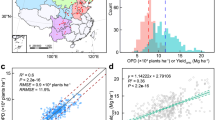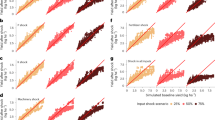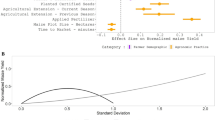Abstract
Crop yields across sub-Saharan Africa are much lower than what is attainable given the environmental conditions and available technologies. Closing this ‘ecological yield gap’ is considered an important food security and rural welfare goal. It is not clear, however, whether it is economically sensible for farmers to substantially increase crop yields. Here we estimate the local yield response of maize to fertilizer across sub-Saharan Africa with an empirical machine-learning model based on 12,081 trial observations and with a mechanistic model. We show that the average ‘economic yield gap’—the difference between current yield and profit-maximizing yield—is about one-quarter of the ecological yield gap. Furthermore, although maize yields could be profitably doubled, the economic incentives to do so may be weak. Our findings suggest that agricultural intensification in sub-Saharan Africa could be supported by complementary agronomic approaches to improve soil fertility, lowering the fertilizer cost, and by spatial targeting of fertilizer recommendations.
This is a preview of subscription content, access via your institution
Access options
Access Nature and 54 other Nature Portfolio journals
Get Nature+, our best-value online-access subscription
$29.99 / 30 days
cancel any time
Subscribe to this journal
Receive 12 digital issues and online access to articles
$119.00 per year
only $9.92 per issue
Buy this article
- Purchase on Springer Link
- Instant access to full article PDF
Prices may be subject to local taxes which are calculated during checkout





Similar content being viewed by others
Data availability
The experimental data compiled for the current study are available at https://dataverse.harvard.edu/dataset.xhtml?persistentId=doi:10.7910/DVN/O9FYCV.
Code availability
The R code used is available at https://github.com/reagro/ecyldgap.
References
Ray, D. K., Ramankutty, N., Mueller, N. D., West, P. C. & Foley, J. A. Recent patterns of crop yield growth and stagnation. Nat. Commun. 3, 1293 (2012).
FAOSTAT (FAO, 2021); http://www.fao.org/faostat/en/#home
Van Ittersum, M. K. et al. Can sub-Saharan Africa feed itself? Proc. Natl Acad. Sci. USA 113, 14964–14969 (2016).
Lobell, D. B., Cassman, K. G. & Field, C. B. Crop yield gaps: their importance, magnitudes, and causes. Annu. Rev. Environ. Resour. 34, 179–204 (2009).
Ligon, E. & Sadoulet, E. Estimating the relative benefits of agricultural growth on the distribution of expenditures. World Dev. 109, 417–428 (2018).
Alwang, J. et al. Pathways from research on improved staple crop germplasm to poverty reduction for smallholder farmers. Agric. Syst. 172, 16–27 (2019).
Holden, S. T. Fertilizer and sustainable intensification in sub-Saharan Africa. Glob. Food Sec. 18, 20–26 (2018).
Foley, J. A. et al. Solutions for a cultivated planet. Nature 478, 337–342 (2011).
Pelletier, J., Ngoma, H., Mason, N. M. & Barrett, C. B. Does smallholder maize intensification reduce deforestation? Evidence from Zambia. Glob. Environ. Change 63, 102127 (2020).
Global Yield Gap and Water Productivity Atlas (University of Nebraska Lincoln, Wageningen University); www.yieldgap.org
Breman, H. & Debrah, S. Improving African food security. SAIS Rev. 23, 153–170 (2003).
Vanlauwe, B. et al. Integrated soil fertility management: operational definition and consequences for implementation and dissemination. Outlook Agric. 39, 17–24 (2010).
Leitner, S. et al. Closing maize yield gaps in sub-Saharan Africa will boost soil N2O emissions. Curr. Opin. Environ. Sustain. 47, 95–105 (2020).
Heisey, P. W. & Mwangi, W. M., Fertilizer Use and Maize Production in Sub-Saharan Africa CIMMYT Economics Working Paper 96-01 (CIMMYT, 1996).
Vanlauwe, B. et al. Agronomic use efficiency of N fertilizer in maize-based systems in sub-Saharan Africa within the context of integrated soil fertility management. Plant Soil 339, 35–50 (2011).
Snapp, S., Jayne, T. S., Mhango, W., Benson, T. & Ricker-Gilbert, J. in National Symposium on Eight Years of FISP—Impact and What Next 14–15 (2014).
Ichami, S. M., Shepherd, K. D., Sila, A. M., Stoorvogel, J. J. & Hoffland, E. Fertilizer response and nitrogen use efficiency in African smallholder maize farms. Nutr. Cycling Agroecosyst. 113, 1–19 (2019).
Rurinda, J. et al. Science-based decision support for formulating crop fertilizer recommendations in sub-Saharan Africa. Agric. Syst. 180, 102790 (2020).
Ten Berge, H. F. et al. Maize crop nutrient input requirements for food security in sub-Saharan Africa. Glob. Food Sec. 23, 9–21 (2019).
Marenya, P. P. & Barrett, C. B. Soil quality and fertilizer use rates among smallholder farmers in western Kenya. Agric. Econ. 40, 561–572 (2019).
Matsumoto, T. & Yamano, T. in Emerging Development of Agriculture in East Africa 117–132 (Springer, 2011).
Sheahan, M., Black, R. & Jayne, T. S. Are Kenyan farmers under-utilizing fertilizer? Implications for input intensification strategies and research. Food Policy 41, 39–52 (2013).
Burke, W. J., Jayne, T. S. & Black, J. R. Factors explaining the low and variable profitability of fertilizer application to maize in Zambia. Agric. Econ. 48, 115–126 (2017).
Koussoubé, E. & Nauges, C. Returns to fertiliser use: does it pay enough? Some new evidence from sub-Saharan Africa. Eur. Rev. Agric. Econ. 44, 183–210 (2017).
Xu, Z., Guan, Z., Jayne, T. S. & Black, R. Factors influencing the profitability of fertilizer use on maize in Zambia. Agric. Econ. 40, 437–446 (2009).
Liverpool-Tasie, L. S. O., Omonona, B. T., Sanou, A. & Ogunleye, W. O. Is increasing inorganic fertilizer use for maize production in SSA a profitable proposition? Evidence from Nigeria. Food Policy 67, 41–51 (2017).
Spatially-Disaggregated Crop Production Statistics Data in Africa South of the Saharan for 2017 (International Food Policy Research Institute, 2020); https://doi.org/10.7910/DVN/FSSKBW
Breman, H. & De Wit, C. T. Rangeland productivity and exploitation in the Sahel. Science 221, 1341–1347 (1983).
Bationo, A. & Mokwunye, A. U. in Alleviating Soil Fertility Constraints to Increased Crop Production in West Africa 195–215 (Springer, 1991).
Levins, R. The strategy of model building in population ecology. Am. Sci. 54, 421–431 (1996).
Kaizzi, K. C. et al. Maize response to fertilizer and nitrogen use efficiency in Uganda. Agron. J. 104, 73–82 (2012).
Laajaj, R., Macours, K., Masso, C., Thuita, M. & Vanlauwe, B. Reconciling yield gains in agronomic trials with returns under African smallholder conditions. Sci. Rep. 10, 1–15 (2020).
Abay, K. A., Bevis, L. & Barrett, C. B. Measurement error mechanisms matter: agricultural intensification with farmer misperceptions and misreporting. Am. J. Agric. Econ. 103, 498–522 (2019).
Wahab, I. In-season plot area loss and implications for yield estimation in smallholder rainfed farming systems at the village level in sub-Saharan Africa. GeoJournal 85, 1–20 (2019).
Bonilla Cedrez, C., Chamberlin, J., Guo, Z. & Hijmans, R. J. Spatial variation in fertilizer prices in sub-Saharan Africa. PLoS ONE 15, e0227764 (2020).
Paliwal, A. & Jain, M. The accuracy of self-reported crop yield estimates and their ability to train remote sensing algorithms. Front. Sustain. Food Syst. 4, 25 (2020).
Kravchenko, A. N., Snapp, S. S. & Robertson, G. P. Field-scale experiments reveal persistent yield gaps in low-input and organic cropping systems. Proc. Natl Acad. Sci. USA 114, 926–931 (2017).
Global Agricultural Research Data Innovation Acceleration Network (GARDIAN, 2020); https://gardian.bigdata.cgiar.org/#!/
Cedrez, C. B., Chamberlin, J. & Hijmans, R. J. Seasonal, annual, and spatial variation in cereal prices in sub-Saharan Africa. Glob. Food Sec. 26, 100438 (2020).
You, L. et al. What is the irrigation potential for Africa? A combined biophysical and socioeconomic approach. Food Policy. 36, 770–782 (2011).
Benami, E. et al. Uniting remote sensing, crop modelling and economics for agricultural risk management. Nat. Rev. Earth Environ. 2, 140–159 (2021).
Minten, B., Koru, B. & Stifel, D. The last mile(s) in modern input distribution: pricing, profitability, and adoption. Agric. Econ. 44, 629–646 (2013).
World Development Report 2009: Reshaping Economic Geography (World Bank, 2009).
Mukasa, A. N. Technology adoption and risk exposure among smallholder farmers: panel data evidence from Tanzania and Uganda. World Dev. 105, 299–309 (2018).
Le Cotty, T., Maitre D’Hotel, E. & Ndiaye, M. Transport costs and food price volatility in Africa. J. Afr. Econ. 26, 625–654 (2017).
Dorward, A. & Chirwa, E. The Malawi agricultural input subsidy programme: 2005/06 to 2008/09. Int. J. Agric. Sustain. 9, 232–247 (2011).
Day, J. C., Hughes, D. W. & Butcher, W. R. Soil, water and crop management alternatives in rainfed agriculture in the Sahel: an economic analysis. Agric. Econ. 7, 267–287 (1992).
Bationo, A., Bielders, C. L., Duivenbooden, N. V., Buerkert, A. C. & Seyni, F. The Management of Nutrients and Water in the West African Semi-arid Tropics IAEA-TECDOC-1026 (IAEA, 1998).
Vanlauwe, B. A fourth principle is required to define conservation agriculture in sub-Saharan Africa: the appropriate use of fertilizer to enhance crop productivity. Field Crops Res. 155, 10–13 (2014).
Droppelmann, K. J., Snapp, S. S. & Waddington, S. R. Sustainable intensification options for smallholder maize-based farming systems in sub-Saharan Africa. Food Sec. 9, 133–150 (2017).
Sileshi, G., Akinnifesi, F. K., Ajayi, O. C. & Place, F. Meta-analysis of maize yield response to woody and herbaceous legumes in sub-Saharan Africa. Plant Soil 307, 1–19 (2008).
Mapfumo, P. & Giller, K. E. Soil Fertility Management Strategies and Practices by Smallholder Farmers in Semi-arid Areas of Zimbabwe (ICRISAT/FAO, 2001).
Takahashi, K., Muraoka, R. & Otsuka, K. Technology adoption, impact, and extension in developing countries’ agriculture: a review of the recent literature. Agric. Econ. 51, 31–45 (2020).
Ayalew, H., Chamberlin, J. & Newman, C. Site-specific Agronomic Information and Technology Adoption: A Field Experiment from Ethiopia tep0620 (Trinity College Dublin, 2020).
Netting, R. M., Stone, M. P. & Stone, G. D. Kofyar cash-cropping: choice and change in indigenous agricultural development. Human Ecology 17, 299–319 (1989).
Boserup, E. The Conditions of Agricultural Growth: The Economics of Agrarian Change under Population Pressure (Transaction, 2011).
Ollenburger, M., Crane, T., Descheemaeker, K. & Giller, K. E. Are farmers searching for an African green revolution? Exploring the solution space for agricultural intensification in Southern Mali. Exp. Agric. 55, 288–310 (2019).
Liaw, A. & Wiener, M. Classification and regression by randomForest. R news 2, 18–22 (2002).
Hijmans, R. J. terra: spatial data analysis. R package version 0.7-11 (2020); https://CRAN.R-project.org/package=Rwofost
Leenaars, J. G. B. et al. Gridded Functional Soil Information (Dataset RZ-PAWHC SSA v.1.0) (2015).
Hengl, T. et al. Soil nutrient maps of sub-Saharan Africa: assessment of soil nutrient content at 250 m spatial resolution using machine learning. Nutr. Cycling Agroecosyst. 109, 77–102 (2017).
Fick, S. E. & Hijmans, R. J. WorldClim 2: new 1‐km spatial resolution climate surfaces for global land areas. Int. J. Climatol. 37, 4302–4315 (2017).
Harris, I. P. D. J., Jones, P. D., Osborn, T. J. & Lister, D. H. Updated high‐resolution grids of monthly climatic observations—the CRU TS3.10 dataset. Int. J. Climatol. 34, 623–642 (2014).
de Wit, A. et al. 25 years of the WOFOST cropping systems model. Agric. Syst. 168, 154–167 (2019).
Hijmans, R. J. Rwofost: WOFOST crop growth simulation model. R package version 0.7-0 (2020); https://CRAN.R-project.org/package=Rwofost
Van Ittersum, M. K. & Rabbinge, R. Concepts in production ecology for analysis and quantification of agricultural input–output combinations. Field Crops Res. 52, 197–208 (1997).
Janssen, B. H. et al. A system for quantitative evaluation of the fertility of tropical soils (QUEFTS). Geoderma 46, 299–318 (1990).
Sattari, S. Z., Van Ittersum, M. K., Bouwman, A. F., Smit, A. L. & Janssen, B. H. Crop yield response to soil fertility and N, P, K inputs in different environments: testing and improving the QUEFTS model. Field Crops Res. 157, 35–46 (2014).
Hijmans, R. J. Rquefts: quantitative evaluation of the native fertility of tropical soils. R package version 1.1-1 (2020); https://CRAN.R-project.org/package=Rquefts
Nelson, A. et al. A suite of global accessibility indicators. Sci. Data 6, 266 (2019).
LandScan High Resolution Global Population Data Set (LandScan, 2016); https://landscan.ornl.gov/
Xiong, J. et al. NASA Making Earth System Data Records for Use in Research Environments (MEaSUREs) Global Food Security-support Analysis Data (GFSAD) Cropland Extent 2015 Africa 30 m V001 [Dataset] (NASA EOSDIS Land Processes DAAC, 2017); https://doi.org/10.5067/MEaSUREs/GFSAD/GFSAD30AFCE.001
Acknowledgements
Funding for this project was provided by the Feed the Future Sustainable Intensification Innovation Lab (SIIL) through USAID (grant number AID-OOA-L-14-00006) (R.J.H.), by the Bill and Melinda Gates Foundation through the Taking Maize Agronomy to Scale in Africa (TAMASA) project (investment number INV-008260) (J.C.) and by the MAIZE CGIAR Research Program led by the International Maize and Wheat Improvement Center (CIMMYT) (J.C.).
Author information
Authors and Affiliations
Contributions
C.B.-C., J.C. and R.J.H. conceived the research. C.B.-C. performed the data acquisition and processing. C.B.-C. and R.J.H. analysed the data. C.B.-C., J.C. and R.J.H. wrote the manuscript.
Corresponding author
Ethics declarations
Competing interests
The authors declare no competing interests.
Additional information
Peer review information Nature Food thanks Andrew Nelson, Liangzhi You and the other, anonymous, reviewer(s) for their contribution to the peer review of this work.
Publisher’s note Springer Nature remains neutral with regard to jurisdictional claims in published maps and institutional affiliations.
Supplementary information
Supplementary Information
Text for Supplementary Fig. 1, Figs. 1–8 and Tables 1–3.
Rights and permissions
About this article
Cite this article
Bonilla-Cedrez, C., Chamberlin, J. & Hijmans, R.J. Fertilizer and grain prices constrain food production in sub-Saharan Africa. Nat Food 2, 766–772 (2021). https://doi.org/10.1038/s43016-021-00370-1
Received:
Accepted:
Published:
Issue Date:
DOI: https://doi.org/10.1038/s43016-021-00370-1
This article is cited by
-
A better use of fertilizers is needed for global food security and environmental sustainability
Agriculture & Food Security (2023)
-
Projected landscape-scale repercussions of global action for climate and biodiversity protection
Nature Communications (2023)
-
Agricultural input shocks affect crop yields more in the high-yielding areas of the world
Nature Food (2023)
-
Spatially differentiated nitrogen supply is key in a global food–fertilizer price crisis
Nature Sustainability (2023)
-
Farmer responses to an input subsidy and co-learning program: intensification, extensification, specialization, and diversification?
Agronomy for Sustainable Development (2023)



